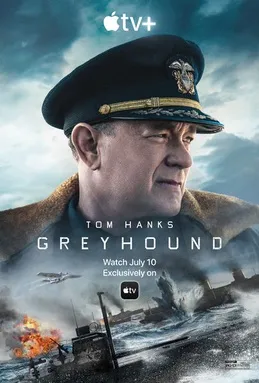Historical accuracy of Greyhound

Historical accuracy of Greyhound

Characters
Commander Ernest Krause
Fictional character from the novel, not based on a single real person (though possibly inspired partly by Cmdr. George P. Hunter). Represents the many US Navy Reserve officers given critical commands early in the war. His stress and dedication are portrayed realistically.
Lieutenant Commander Cole
Fictional character representing the second-in-command on a WWII destroyer.
George Cleveland
Fictional character representing junior enlisted crew, specifically African-Americans who often served in steward/mess attendant roles in the segregated US Navy of 1942. His presence is historically plausible.
Various Bridge Crew
Fictional characters performing essential roles. Their actions and the terminology they use largely reflect accurate WWII naval procedures.
German U-boat Commander ("Grey Wolf")
A fictional device for dramatic tension. Direct radio taunting between U-boats and escort commanders was highly unlikely/undocumented due to the risk of detection (via HF/DF).
Captain of HMCS Dodge ("Dicky")
Represents the Allied nature of escort groups.
More characters
Captain of HMS James ("Harry")
Represents the Allied nature of escort groups.
Captain of ORP Viktor ("Eagle")
Represents the Allied nature of escort groups, including Polish naval forces who fought with the Allies.
Story
Convoy crossing the North Atlantic (1942)
While the specific convoy (HX-25 designation used fictionally) and events are fictional, the scenario of Allied convoys facing U-boat attacks in early 1942 is historically accurate context.
Traversing the Mid-Atlantic "Black Pit"
Accurately depicts the real danger zone in the mid-Atlantic where land-based air cover could not reach, leaving convoys most vulnerable to U-boats.
U-boat Wolfpack tactics
Realistically shows multiple U-boats coordinating attacks to overwhelm the escort screen, often striking at night or in poor weather.
Destroyer anti-submarine warfare (ASW) tactics
Accurately portrays the use of sonar (ASDIC) for underwater detection, radar for surface contacts, depth charge attacks, and maneuvering to hunt U-boats, reflecting early 1942 capabilities.
Use of HF/DF ("Huff-Duff")
Shows the use of High-Frequency Direction Finding to locate transmitting U-boats, a crucial piece of Allied technology in the Battle of the Atlantic.
Radio communication/taunting from U-boat
Direct voice communication and taunting from a U-boat commander to an escort commander over the radio is considered highly improbable and done for dramatic effect. U-boats prioritized radio silence.
Relentless pace and crew exhaustion
Effectively conveys the constant tension, lack of sleep, harsh conditions, and immense psychological strain experienced by escort crews during prolonged U-boat attacks.
Sinking multiple U-boats
Escorts did sink U-boats, but confirming kills was difficult. The film might depict a higher concentration of successful sinkings than typical for a single escort over a short period in early 1942.
Losses of merchant ships and an escort ("Eagle")
Realistically portrays that convoys suffered losses, and escort vessels themselves were vulnerable and could be damaged or sunk during engagements.
Close-quarters battle with surfaced U-boat
Inspired by real incidents (like USS Borie vs. U-405) where destroyers engaged surfaced U-boats at close range, sometimes resorting to small arms fire when main guns couldn't depress enough.
Burial at sea ceremony
Shows the somber reality of casualties aboard ship and the traditional naval procedure for burial at sea during wartime.
Polish destroyer captain asking permission to abandon ship
A warship captain has the authority to abandon ship if deemed necessary; they would inform the escort commander, not ask permission.
Setting
USS Keeling ("Greyhound") depiction
Name/number fictional. Visually based on a Fletcher-class destroyer (accurate appearance, but class entered service later in 1942). Filmed on museum ship USS Kidd (Fletcher-class), lending authenticity to visuals/layouts.
Multinational escort group (UK, Canada, Poland)
Accurately reflects the composition of Allied escort groups, which often included ships from various Allied navies working together.
Depiction of merchant vessels (tankers, freighters)
Realistically shows the types of vulnerable cargo ships that made up the convoys and were the primary targets of U-boats.
Depiction of German U-boats (Type VII)
Visually represents the Type VII U-boat, the most common type used in the Battle of the Atlantic.
North Atlantic weather and sea conditions
Effectively portrays the harsh, cold, often stormy, and challenging environment faced by ships operating in the North Atlantic.
Technology (Radar, Sonar/ASDIC, HF/DF, Depth Charges)
Accurately shows the capabilities and limitations of key ASW technologies available to escorts in early 1942.
Naval terminology and procedures
Highly praised for its generally accurate use of naval language, bridge commands, plotting, communication protocols, and operational procedures, enhancing the film's realism (though some specific helm commands debated).
Life aboard a WWII destroyer
Conveys the cramped, cold, wet, constantly moving, and stressful living and working conditions for sailors on escort duty.
